Jazz Read online
Contents
Title Page
Dedication
Epigraph
Foreword
Begin Reading
About the Author
Also by Toni Morrison
Acclaim for Toni Morrison’s JAZZ
Copyright
for R W
and
George
I am the name of the sound
and the sound of the name.
I am the sign of the letter
and the designation of the division.
“Thunder, Perfect Mind,”
The Nag Hammadi
FOREWORD
“She stood there licking snowflakes from her top lip, her body shaking everywhere except the left hand which held the knife…”
It didn’t work, this opening sentence to Jazz, because it made what could follow mechanical and predictable: the inevitability of “Then she…” seemed inappropriate for this project. I was interested in rendering a period in African American life through a specific lens—one that would reflect the content and characteristics of its music (romance, freedom of choice, doom, seduction, anger) and the manner of its expression. I had decided on the period, the narrative line, and the place long ago, after seeing a photograph of a pretty girl in a coffin, and reading the photographer’s recollection of how she got there. In the book The Harlem Book of the Dead, the photographer, James Van Der Zee, tells Camille Billops what he remembers of the girl’s death: “She was the one I think was shot by her sweetheart at a party with a noiseless gun. She complained of being sick at the party and friends said, ‘Well, why don’t you lay down?’ And they took her in the room and laid her down. After they undressed her and loosened her clothes, they saw the blood on her dress. They asked her about it and she said, ‘I’ll tell you tomorrow, yes. I’ll tell you tomorrow.’ She was just trying to give him a chance to get away. For the picture, I placed the flowers on her chest.” Her motives for putting herself at risk by waiting, for accepting a lover’s vengeance as legitimate, seemed so young, so foolish, so wrapped up and entangled in the sacrifice that tragically romantic love demanded. The anecdote seemed to me redolent of the proud hopelessness of love mourned and championed in blues music, and, simultaneously, fired by the irresistible energy of jazz music. It asserted itself immediately and aggressively as the seed of a plot, a story line.
Beloved unleashed a host of ideas about how and what one cherishes under the duress and emotional disfigurement that a slave society imposes. One such idea—love as perpetual mourning (haunting)—led me to consider a parallel one: how such relationships were altered, later, in (or by) a certain level of liberty. An alteration made abundantly clear in the music. I was struck by the modernity that jazz anticipated and directed, and by its unreasonable optimism. Whatever the truth or consequences of individual entanglements and the racial landscape, the music insisted that the past might haunt us, but it would not entrap us. It demanded a future—and refused to regard the past as “…an abused record with no choice but to repeat itself at the crack and no power on earth could lift the arm that held the needle.”
For three years the cast had been taking shape—an older couple born in the South; the impact on them of a new urban liberty; the emotional unmanageableness of radical change from the menace of post-Reconstruction South to the promise of post–WWI North. The couple would be forced to respond to a girl who introduces into their lives a new kind of risk—psychological rather than physical. To reproduce the flavor of the period, I had read issues of every “Colored” newspaper I could for the year 1926. The articles, the advertisements, the columns, the employment ads. I had read Sunday School programs, graduation ceremony programs, minutes of women’s club meetings, journals of poetry, essays. I listened to the scratchy “race” records with labels like Okeh, Black Swan, Chess, Savoy, King, Peacock.
And I remembered.
My mother was twenty years old in 1926; my father nineteen. Five years later, I was born. They had both left the South as children, chock full of scary stories coupled with a curious nostalgia. They played the records, sang the songs, read the press, wore the clothes, spoke the language of the twenties; debating endlessly the status of The Negro.
I remember opening the metal trunk sitting like a treasure chest in the hall. The lock, clasped shut but not key-locked, was thrilling; its round head, the cylinders—everything fit and clicked and obeyed. The lid was heavy, but silent on its hinges; an appropriately stealthy entrance into this treasure that I have been cautioned never, ever, to approach. I am too young to be in school, and the days are endless without my sister. She is solemn and important, now that she has a daily appointment (first grade) and I have nothing to do. My mother is in the backyard. No one else is in the house, so no one will know how accommodating the lock is, how quietly the lid rises. The treasure I believe is hidden there does not disappoint. Right on top of crepe dresses is an evening purse, tiny, jeweled with fringe dangled in jet and glass.
My mother hears the scream but I don’t. I only remember the crack of pain as the trunk lid smashes my hand, then waking up in her arms. I thought she would be angry at me for my disobedience, but she is not. She is soothing, sings a little, as she massages my hand, rubs it with a triangle of ice. I had fainted. What an adult thing to do! How jealous my sister will be when I tell her about the pain, how grown up I felt and how loved. But seeing, examining the purse, the treasure—I would not describe that to her. I would keep this glimpse of my mother’s world before I was born to myself. It was private. It was glittery. And now, it was mine as well.
Following Beloved’s focus on mother-love, I intended to examine couple-love—the reconfiguration of the “self” in such relationships; the negotiation between individuality and commitment to another. Romantic love seemed to me one of the fingerprints of the twenties, and jazz its engine.
Although I had a concept, its context, a plot line, characters, data, I could not establish the structure where meaning, rather than information, would lie; where the project came as close as it could to its idea of itself—the essence of the so-called Jazz Age. The moment when an African American art form defined, influenced, reflected a nation’s culture in so many ways: the bourgeoning of sexual license, a burst of political, economic, and artistic power; the ethical conflicts between the sacred and the secular; the hand of the past being crushed by the present. Primary among these features, however, was invention. Improvisation, originality, change. Rather than be about those characteristics, the novel would seek to become them.
My effort to enter that world was constantly being frustrated. I couldn’t locate the voice, or position the eye. The story opened with the betrayed wife intent on killing her rival. “She stood there licking snowflakes from her top lip….” Okay, perhaps. Perhaps. But nothing that could pull from the material or the people the compositional drama of the period, its unpredictability. I knew everything about this wife and, angered by my inability to summon suitable language to reveal her, I threw my pencil on the floor, sucked my teeth in disgust, thinking, “Oh, shoot! What is this? I know that woman. I know her skirt size, what side she sleeps on. I know the name of her hair oil, its scent….” So that’s what I wrote, effortlessly without pause, playing, just playing along with the voice, not even considering who the “I” was until it seemed natural, inevitable, that the narrator could—would—parallel and launch the process of invention, of improvisation, of change. Commenting, judging, risking, and learning. I had written novels in which structure was designed to enhance meaning; here the structure would equal meaning. The challenge was to expose and bury the artifice and to take practice beyond the rules. I didn’t want simply a musical background, or decorative references to it. I wanted the work to be a manifestation of the music’s intellect, sens
uality, anarchy; its history, its range, and its modernity.
She sang, my mother, the way other people muse. A constant background drift of beautiful sound I took for granted, like oxygen. “Ave Maria, gratia plena… I woke up this morning with an awful aching head/My new man has left me just a room and a bed…. Precious Lord, lead me on… I’m gonna buy me a pistol, just as long as I am tall…. L’amour est un oiseau rebel…. When the deep purple falls over hazy garden walls… I’ve got a disposition and a way of my own/When my man starts kicking I let him find a new home…. Oh, holy night….” Like the music that came to be known as Jazz, she took from everywhere, knew everything—gospel, classic, blues, hymns—and made it her own.
How interesting it would be to raise the atmosphere, choose the palette, plumb the sounds of her young life, and convert it all into language as seductive, as glittery, as an evening purse tucked away in a trunk!
Sth, I know that woman. She used to live with a flock of birds on Lenox Avenue. Know her husband, too. He fell for an eighteen-year-old girl with one of those deepdown, spooky loves that made him so sad and happy he shot her just to keep the feeling going. When the woman, her name is Violet, went to the funeral to see the girl and to cut her dead face they threw her to the floor and out of the church. She ran, then, through all that snow, and when she got back to her apartment she took the birds from their cages and set them out the windows to freeze or fly, including the parrot that said, “I love you.”
The snow she ran through was so windswept she left no footprints in it, so for a time nobody knew exactly where on Lenox Avenue she lived. But, like me, they knew who she was, who she had to be, because they knew that her husband, Joe Trace, was the one who shot the girl. There was never anyone to prosecute him because nobody actually saw him do it, and the dead girl’s aunt didn’t want to throw money to helpless lawyers or laughing cops when she knew the expense wouldn’t improve anything. Besides, she found out that the man who killed her niece cried all day and for him and for Violet that is as bad as jail.
Regardless of the grief Violet caused, her name was brought up at the January meeting of the Salem Women’s Club as someone needing assistance, but it was voted down because only prayer—not money—could help her now, because she had a more or less able husband (who needed to stop feeling sorry for himself), and because a man and his family on 134th Street had lost everything in a fire. The Club mobilized itself to come to the burnt-out family’s aid and left Violet to figure out on her own what the matter was and how to fix it.
She is awfully skinny, Violet; fifty, but still good looking when she broke up the funeral. You’d think that being thrown out the church would be the end of it—the shame and all—but it wasn’t. Violet is mean enough and good looking enough to think that even without hips or youth she could punish Joe by getting herself a boyfriend and letting him visit in her own house. She thought it would dry his tears up and give her some satisfaction as well. It could have worked, I suppose, but the children of suicides are hard to please and quick to believe no one loves them because they are not really here.
Anyway, Joe didn’t pay Violet or her friend any notice. Whether she sent the boyfriend away or whether he quit her, I can’t say. He may have come to feel that Violet’s gifts were poor measured against his sympathy for the brokenhearted man in the next room. But I do know that mess didn’t last two weeks. Violet’s next plan—to fall back in love with her husband—whipped her before it got on a good footing. Washing his handkerchiefs and putting food on the table before him was the most she could manage. A poisoned silence floated through the rooms like a big fishnet that Violet alone slashed through with loud recriminations. Joe’s daytime listlessness and both their worrying nights must have wore her down. So she decided to love—well, find out about—the eighteen-year-old whose creamy little face she tried to cut open even though nothing would have come out but straw.
Violet didn’t know anything about the girl at first except her name, her age, and that she was very well thought of in the legally licensed beauty parlor. So she commenced to gather the rest of the information. Maybe she thought she could solve the mystery of love that way. Good luck and let me know.
She questioned everybody, starting with Malvonne, an upstairs neighbor—the one who told her about Joe’s dirt in the first place and whose apartment he and the girl used as a love nest. From Malvonne she learned the girl’s address and whose child she was. From the legally licensed beauticians she found out what kind of lip rouge the girl wore; the marcelling iron they used on her (though I suspect that girl didn’t need to straighten her hair); the band the girl liked best (Slim Bates’ Ebony Keys which is pretty good except for his vocalist who must be his woman since why else would he let her insult his band). And when she was shown how, Violet did the dance steps the dead girl used to do. All that. When she had the steps down pat—her knees just so—everybody, including the ex-boyfriend, got disgusted with her and I can see why. It was like watching an old street pigeon pecking the crust of a sardine sandwich the cats left behind. But Violet was nothing but persistent and no wisecrack or ugly look stopped her. She haunted PS-89 to talk to teachers who knew the girl. JHS-139 too because the girl went there before trudging way over to Wadleigh, since there were no high schools in her district a colored girl could attend. And for a long time she pestered the girl’s aunt, a dignified lady who did fine work off and on in the garment district, until the aunt broke down and began to look forward to Violet’s visits for a chat about youth and misbehavior. The aunt showed all the dead girl’s things to Violet and it became clear to her (as it was to me) that this niece had been hardheaded as well as sly.
One particular thing the aunt showed her, and eventually let Violet keep for a few weeks, was a picture of the girl’s face. Not smiling, but alive at least and very bold. Violet had the nerve to put it on the fireplace mantel in her own parlor and both she and Joe looked at it in bewilderment.
It promised to be a mighty bleak household, what with the birds gone and the two of them wiping their cheeks all day, but when spring came to the City Violet saw, coming into the building with an Okeh record under her arm and carrying some stewmeat wrapped in butcher paper, another girl with four marcelled waves on each side of her head. Violet invited her in to examine the record and that’s how that scandalizing threesome on Lenox Avenue began. What turned out different was who shot whom.
I’m crazy about this City.
Daylight slants like a razor cutting the buildings in half. In the top half I see looking faces and it’s not easy to tell which are people, which the work of stonemasons. Below is shadow where any blasé thing takes place: clarinets and lovemaking, fists and the voices of sorrowful women. A city like this one makes me dream tall and feel in on things. Hep. It’s the bright steel rocking above the shade below that does it. When I look over strips of green grass lining the river, at church steeples and into the cream-and-copper halls of apartment buildings, I’m strong. Alone, yes, but top-notch and indestructible—like the City in 1926 when all the wars are over and there will never be another one. The people down there in the shadow are happy about that. At last, at last, everything’s ahead. The smart ones say so and people listening to them and reading what they write down agree: Here comes the new. Look out. There goes the sad stuff. The bad stuff. The things-nobody-could-help stuff. The way everybody was then and there. Forget that. History is over, you all, and everything’s ahead at last. In halls and offices people are sitting around thinking future thoughts about projects and bridges and fast-clicking trains underneath. The A&P hires a colored clerk. Big-legged women with pink kitty tongues roll money into green tubes for later on; then they laugh and put their arms around each other. Regular people corner thieves in alleys for quick retribution and, if he is stupid and has robbed wrong, thieves corner him too. Hoodlums hand out goodies, do their best to stay interesting, and since they are being watched for excitement, they pay attention to their clothes and the carving out of insults. N
obody wants to be an emergency at Harlem Hospital but if the Negro surgeon is visiting, pride cuts down the pain. And although the hair of the first class of colored nurses was declared unseemly for the official Bellevue nurse’s cap, there are thirty-five of them now—all dedicated and superb in their profession.
Nobody says it’s pretty here; nobody says it’s easy either. What it is is decisive, and if you pay attention to the street plans, all laid out, the City can’t hurt you.
I haven’t got any muscles, so I can’t really be expected to defend myself. But I do know how to take precaution. Mostly it’s making sure no one knows all there is to know about me. Second, I watch everything and everyone and try to figure out their plans, their reasonings, long before they do. You have to understand what it’s like, taking on a big city: I’m exposed to all sorts of ignorance and criminality. Still, this is the only life for me. I like the way the City makes people think they can do what they want and get away with it. I see them all over the place: wealthy whites, and plain ones too, pile into mansions decorated and redecorated by black women richer than they are, and both are pleased with the spectacle of the other. I’ve seen the eyes of black Jews, brimful of pity for everyone not themselves, graze the food stalls and the ankles of loose women, while a breeze stirs the white plumes on the helmets of the UNIA men. A colored man floats down out of the sky blowing a saxophone, and below him, in the space between two buildings, a girl talks earnestly to a man in a straw hat. He touches her lip to remove a bit of something there. Suddenly she is quiet. He tilts her chin up. They stand there. Her grip on her purse slackens and her neck makes a nice curve. The man puts his hand on the stone wall above her head. By the way his jaw moves and the turn of his head I know he has a golden tongue. The sun sneaks into the alley behind them. It makes a pretty picture on its way down.

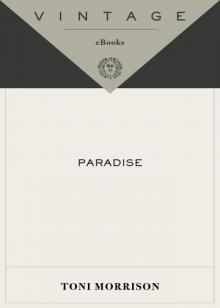 Paradise
Paradise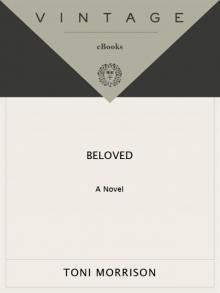 Beloved
Beloved Home
Home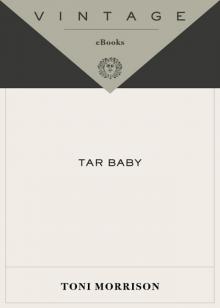 Tar Baby
Tar Baby The Bluest Eye
The Bluest Eye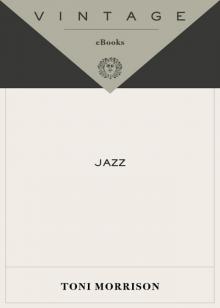 Jazz
Jazz Love
Love Sula
Sula Mouth Full of Blood
Mouth Full of Blood Song of Solomon
Song of Solomon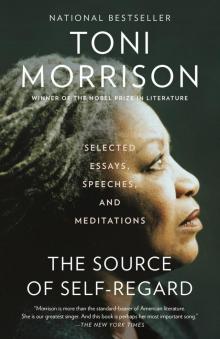 The Source of Self-Regard
The Source of Self-Regard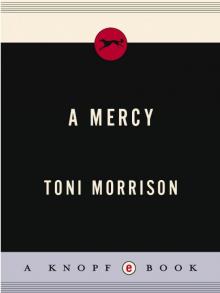 A Mercy
A Mercy Beloved_a novel
Beloved_a novel